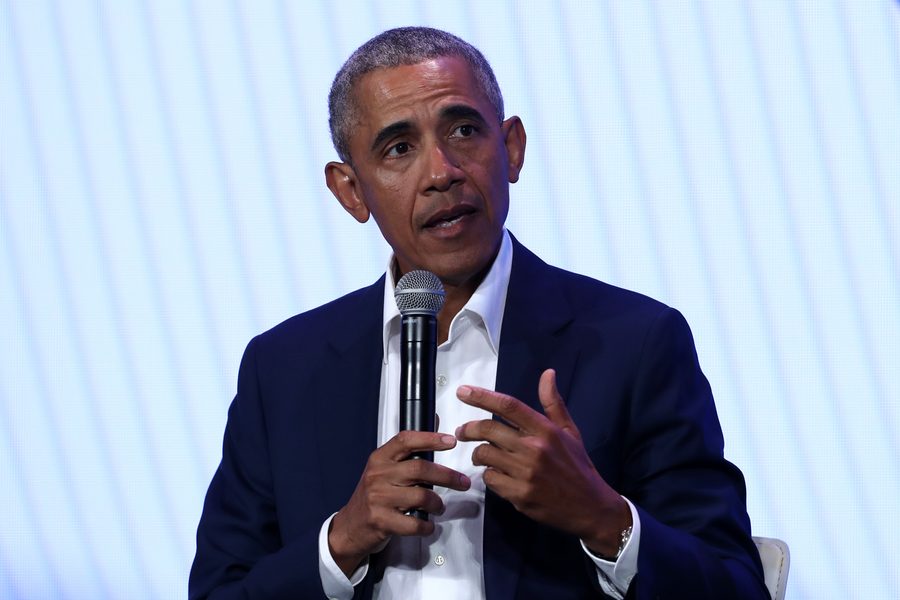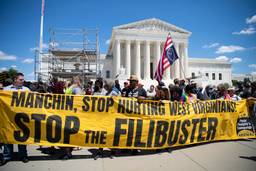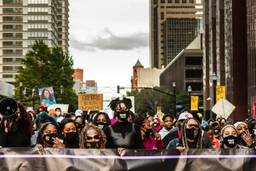
Barack Obama didn’t break any new ground when, at last month’s national gathering of the “My Brother’s Keeper Alliance” in Oakland, California, he cracked jokes about the self-defeating qualities of a certain type of young black man. Addressing this hypothetical fellow directly, Obama ridiculed him for “wearing an 8-pound chain” and needing “eight women around you twerking” to prove his manhood. The theme — of poor black people undone by their own moral failings — was a major thoroughfare throughout his presidency, one that Obama traveled again and again when confronting black communities struggling under capitalism.
But this analysis is at war with the one put forward by many of the activists in those communities. Assata’s Daughters, which says it “grew out of a critical gap in Chicago of programming for young women to get trained up in the radical political tradition of Black feminism,” rejects the idea that there’s anything uniquely wrong with black people. Instead,the group sees a set of predictable outcomes created by a few hundred years of racist public policy: grinding poverty, higher rates of violent crime and incarceration, and tragically worse outcomes of health and education. You won’t overcome any of it, the group argues, by barking at black people to run for higher moral ground. The much more serious path is to support black people as they struggle for greater participation in political and economic life.
A blueprint for liberation
To be fair, the former president usually eases into his episodes with an acknowledgement that American history and policy have been somewhat unkind to black people. But the show then veers sharply from looking at that vast landscape of structural misdeed to the narrow and personal shortcomings of the community he’s addressing. At the gathering in Oakland, the former president’s performance went down according to script.
From the beginning, black writers, thinkers and activists have fiercely criticized this ritual. Derecka Purnell summed it up nicely in a recent New York Times article:
Programs like My Brother’s Keeper insist on making better versions of Trayvon Martin, the black victim, instead of asking how to stop creating people like George Zimmerman, the racist vigilante. Rather than encouraging them to dismantle the systems that deepen wealth inequality, Mr. Obama tells black boys to tuck their chains.
The complaint here is simple: Rather than offering a possible blueprint for transforming the systems that have so devastated black communities, Obama lights into poor black people for failing to lead upright lives in the face of that devastation.
Black boys have “a more difficult time in this society for a whole range of historical reasons,” Obama concedes. And he agrees that the government has “a role to play in making sure that policies were put in place that weren’t systematically disadvantaging young men of color.”
But that’s about as close as Obama gets to acknowledging that a nation with a nasty history of “disadvantaging young men of color” may require an actual contest for political power over that nation’s institutions. There’s nothing, for instance, about the nationwide battles young black people are leading to pry away big chunks of local police budgets — and invest those resources in community priorities, like schools and mental health clinics. Or to ensure that megaprojects receiving massive public subsidies, like the Obama Presidential Center in Chicago, actually benefit the public. In place of those sorts of contests, My Brother’s Keeper champions programs geared towards young men of color that, as Obama put it, “provide them mentoring, provide them apprenticeships, provide them job training” and will see to it that “that they’ve got some sort of technical program” if college isn’t in the cards.
Compare this, Purnell urges, with the approach put forward by Assata’s Daughters. Also based in Chicago, Assata’s Daughters works “to escalate, deepen, and sustain the larger Black Lives Matter movement” — and offers a much deeper model for change based on building up the power of young black people to alter the balance of power in society. The last thing anyone needs, Page May, co-founder of Assata’s Daughters tells In These Times, is enormously powerful former heads of state harassing young people about their lack of a savings account. Instead, young people need meaningful opportunities to “actually take collective action to change the conditions in which we exist so that our lives can be better.”
That action is taking place on on multiple fronts — from pushing for the removal of cops from Chicago schools to abolishing money bail and ending pretrial detention.
Assata’s Daughters is also a vital force in the struggle to block the establishment of Mayor Rahm Emanuel’s proposed Police Academy. The mayor’s announcement came amid a still-unfolding nightmare after a white police officer, Jason Van Dyke, pumped 16 bullets into Laquan McDonald, killing the black teenager as he was walking away. It is widely believed that the Emanuel administration attempted to cover up the grisly details and thus prevent the public from holding the involved officers accountable. In response to mass protests and outrage at the police killing, Emanuel is billing the academy as part of a plan to reform the Chicago Police Department — and provide an “economic engine” for the community. Those claims have been met with a mix of horror and outraged disbelief from many.
In response, a massive organizing effort took off under the banner #NoCopAcademy. Outraged by the misplaced priorities represented by the academy, Assata’s Daughters and other grassroots groups came together to “demand community investment and resources for young people instead,” as Juanita Tennyson, a member of Assata’s Daughters explained in an op-ed last year. The group organized teach-ins and press conferences, pressutrf elected representatives, and fanned out across their communities in canvassing drives. The organization even took over a 10-car train to bring attention to their cause.
Tennyson also explains the pivotal role Assata’s Daughters plays in helping young people cultivate empowered political identities capable of transforming not only themselves, but the world. “I had never learned about social movements or how to get involved and create systemic change,” she writes. “But when I joined Assata’s Daughters, everything changed.” The organization “teaches black youth how to organize their community. I was introduced to a world of black girl magic, power-building secrets, and ways to make change.”
A violent system
These are clashing visions for how communities devastated by generations of racial and economic injustice can transform their lives.
For the former president and community organizer, the road to black uplift primarily runs through individuals and their communities rising on their own and occasionally doing politics when things go bad. But for activists interested in a much deeper uprooting of injustice, this is “a distraction from who actually has power in society,” as May puts it. By focusing so squarely on making young black people “more respectable,” she says, you can never “actually get to the root of all of the different types of violence and unnecessary struggle that so many people face.”
It’s worth pausing to look at those roots. After 250 years of enslavement, black Americans had a brief burst of political life in the 14 years of Reconstruction that followed. That was soon snuffed out across the south and much of the north, leaving the newly emancipated at the mercy of a country hellbent on reinstating, as historian Douglas Blackmon describes it, slavery by another name at every level of government. In order to keep that system alive and black people politically and economically powerless, white supremacists, both inside and outside of government, sparked a campaign of domestic terror that burned well into the mid-twentieth century. It wasn’t until the civil rights bills of the mid and late 1960s passed that another small window to democracy was opened.
To put it generously, black Americans have only had a handful of decades when they could meaningfully participate in the decisions that shape their lives. And at every step of the way, a rigid and violent system of segregation has walled in Black communities in a way that makes them easy targets not just for mistreatment, but large-scale economic exploitation.
The evidence of this in our own time is so vast it can be difficult to collect in one place. Black Americans live in an economic world almost entirely separate from that of other Americans. Take wealth. Based on the most recent data from the Federal Reserve Board, the Institute for Policy Studies finds that “the median Black family today owns $3,600 — just 2 percent of the wealth of the median White family.” Even more dire, “black family wealth is on track to reach zero wealth by 2082.” And according to the Brookings Institute, black people who start off poor are “twice as likely to be stuck there as whites,” while “black children born into middle-quintile families are also twice as likely to be downwardly mobile as middle-income whites.”
This all takes place in a country where your ability to climb out of poverty hinges on whether you were lucky enough to have parents who aren’t. In such a world, it just doesn’t matter a whole lot how skilled, educated or “respectable” black children are. Escaping poverty will remain out of reach to a critical mass of them so long as we allow for the persistence of a totally lopsided distribution of wealth.
Taking Obama seriously
And what about Obama’s time in office? Did his policies stop the bleeding? Was he able to at least meet his own minimum standard of “making sure that policies were put in place that weren’t systematically disadvantaging” black communities? He did not. As Briahna Joy Gray of The Intercept points out in a recent piece on reparations, Obama “famously bailed out big banks before homeowners, and black Americans were hit harder than any other group — losing 40 percent of our collective wealth in the crisis.”
Likewise, post-presidency Obama has struggled to match his uplift rhetoric with his actual record. Take the Obama Foundation’s record in Chicago. Activists there have forcefully criticized the former community organizer for deepening the ability of the city’s capitalist class to ravage poor black communities.
For the last couple years, Obama has opposed the adoption of a wildly popular plan sought by the Obama Community Benefits Agreement (CBA) Coalition. The coalition has laid out their proposal on their website, which would “require that jobs be set aside for people in communities around the Obama presidential center; protect low-income housing and home owners; support and create Black businesses; and strengthen neighborhood schools.” In last week’s elections, the CBA received overwhelming support, passing with between 80 and 90 percent approval in affected communities. Despite some likely positive impacts in the lives of some young people of color, the Obama Foundation has piled onto the economic struggles of the city’s poor black communities.
May holds up a damning split-screen image of this scenario. “Obama is telling young men, ‘Pull up your pants,’” she said. At the same time, argues May, he is “taking advantage of Chicago’s finances and exploiting it for his project.” May says that the Obama Presidential Center isa “massive monument to himself that’s going to displace so many young black people from the community.” And in stark contrast with the politically limited philosophy of My Brother’s Keeper, the community has responded with a “massive resistance led by young black people,” insisting that they be given some say in the course of their collective lives.
Expanding our political imagination
Barack Obama has always had his story about the tragic threat black people, and especially the poor among them, pose to their own aspirations to build better lives for themselves and their communities. He isn’t the first. As historian Ibram X. Kendi lays out in Stamped from the Beginning: The Definitive History of Racist Ideas in America, every era has had its version of then-powerful black people scolding poor black people to get their shit together. And each has had some version of, “But how about we just go after the systems that lock so many of us in desperate poverty and second-class citizenship in the first place?” shouted back at them.
Of course, Obama is the former president of the world’s most fantastically wealthy country, and so has had much greater ability to affect the country’s actual institutions and thus the impact they have on people’s actual lives. But organizers’ calls for a radical expansion of our political imaginations still packs the same wallop. Perhaps an even greater one.
“The reality is so much of young poor black people’s lives is controlled by things that they cannot influence,” May reflects. “If you live in public housing and get on a public bus to a public school” after your previous school “got shut down and now you have to go across gang lines” and “deal with CPD,” she says, “those are political issues.”
One response to that is to scold those young people for not overcoming those odds like superheroes. Another, May argues, is providing them a place where they “can participate and understand why things are the way they are and create an alternative vision.”
ELI DAY was an investigative fellow with In These Times’ Leonard C. Goodman Institute for Investigative Reporting. He’s also a Detroiter, where he writes about politics, policy, racial and economic justice. His work has appeared in Vox, Current Affairs, Mother Jones, and the New Republic, among others.







